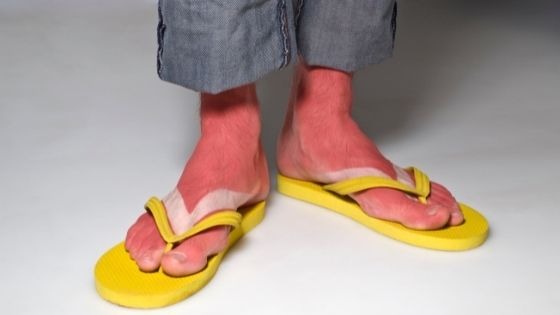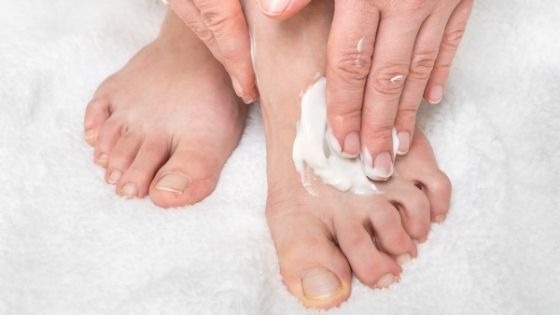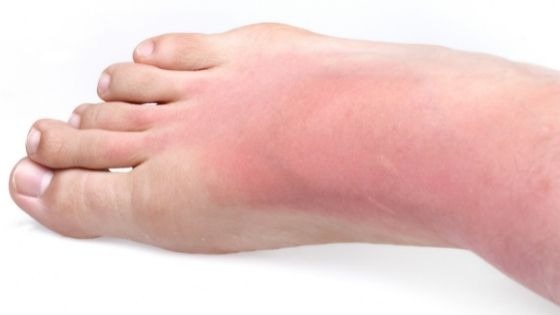9 Tips to Treat Sunburn swelling ankles that actually work!

Sunburn is one of the most common injuries for people who spend time outdoors. It can be painful and troublesome, but it's also preventable.
The best way to protect yourself from sunburn is to avoid exposure during peak hours (10 AM - 4 PM). But what if you forget your sunscreen or don't have time to reapply?
Sunburn ankles are no fun at all! That's why we created this list of tips and tricks. These tips will help ease the pain and get back out there as soon as possible. With these suggestions from our experts, you'll never have to worry about a sunburn again!
What causes sunburn?
According to Nathaniel Josue MD. "The Sun's UV light can cause damage in as little as 15 minutes. Of course, UVA rays are the main culprits, but even a small amount of exposure to UVB will produce burn symptoms."
The Sun can cause sunburned skin and swollen feet. When you get a tan, your body makes more of the thing on your skin that protects it from getting burnt.
A light tan is just when you have more of that stuff than usual on your skin. If you stay in the Sun for too long, it can cause some damage to the cells in your skin and make them burn.
On the other hand, we don't expose to the Sun's rays. So we usually protect them the rest of the year with shoes when we go outside.
When people spend a lot of time getting Sun, without a lot of protection, it is not uncommon for them to get an intense sunburn.
Signs of sunburn
According to Nathaniel Josue. "The most common symptoms are redness, pain, and tightened skin. Sometimes the area can become very warm or swollen."
There is usually a heat-related sensation when you get sunburned, including warmth, tenderness, tightness, and even throbbing in severe cases.
Other symptoms include:
- Inflammation
- Blistering
- Peeling skin
- Itching
- Redness
Swelling, particularly around the ankles and feet because you don't usually wear shoes. The ankle is also commonplace for people to get thrombophlebitis or blood clots in their legs or feet when they are in the Sun for very long.
Sun poisoning, also known as phototoxic or photoallergic reactions, is a temporary condition resulting from exposure to the ultraviolet (UV) rays from the Sun. The result can be a painful redness on your skin that often feels warm and itchy.
Sun poisoning usually disappears within five days after you get out of the Sun. You can treat it by putting cool, wet cloths on the affected areas.
This is what happens when you have unprotected skin that's been exposed to the Sun for too long. It looks pretty bad because your body has started to fight off all of those UV Rays.
If you don't protect your skin, it can lead to skin cancer. Skin cancer is when you get cells that grow into your skin and divide over and over again. So they keep growing in the same place, like a bump on the top of your arm or the side of your leg.
Skin cancer can also happen in other parts of your body, like under your arms or in between your legs. It usually looks brown or black and is hard. Cancer sometimes feels a little bit sore or itchy, but not all the time.
9 Tips to cool sunburned swelling ankles

How do you treat swollen ankles from sunburn? Sunburn is the result of damage to skin cells by ultraviolet rays.
The injured and inflamed skin becomes red, painful, and sensitive to the touch. Usually, the affected area undergoes color changes.
Blisters may also form on the skin, filled with fluid caused by damaged blood vessels under the skin's surface.
Here is how you cool sunburned swelling ankles:
Apply cream
Although it is better to be safe than sorry, if we have forgotten to use sunblock and our foot has burned, we should first apply a cream designed for this sort of sunburn.
Applying cream is a procedure to be repeated several times each day on the burned area. That is because you have to leave an excess for your skin's natural oils to absorb.
If you can, leave the area for one night without walking around. This way, you do not make your wounds worse.
Use aloe vera gel
Aloe vera is a succulent plant from tropical regions. It has been used for millennia to treat burns, wounds, and sunburns.
This treatment can be very effective because it reduces inflammation and provides a cooling effect on your burned skin.
It also has soothing properties that relieve itching and burning sensations, which you will undoubtedly have if you've been sunburned.
The aloe vera will help reduce the chance of blistering and swelling, making it much easier to heal your skin.
Avoid exposure to the Sun.
"If we have burned feet, I recommend not to expose them to the sun for at least a few days until the skin has healed." Dr. Nathaniel says.
Visiting a podiatrist
It is advisable to visit the podiatrist if you have swollen legs and the burn on the feet is very intense. The specialist will be the best person to tell us the steps to follow and if complementary treatment is necessary. Visiting a podiatrist will be especially important if blisters appear.
Take an anti-inflammatory
"Burns inflame the skin, and this can be painful," says Dr. Nathaniel. "You could take aspirin or ibuprofen to reduce swelling, help relieve any discomfort."
Hydrate your body
If you're feeling hot, sweating, and dehydrated all at the same time, it's essential to drink more fluids. So drink more water than usual.
Elevate your feet
Elevating your feet can help to reduce inflammation in the body. Lie down and prop up on pillows so that they are at chest level or higher. Keeping your feet up will keep blood flowing while reducing swelling around the ankles and heels area.
Milk compress
Cool milk can be a lifesaver for those who have burned their feet.
- Soak some gauze or cloth in cold milk.
- Apply the top of your foot with light pressure (very gentle)
- Leave on until it is thoroughly absorbed, then moisten again if necessary!
Potato juice
For those who want to go the natural route, try applying potato juice or paste to treat minor skin irritation and inflammation.
You can grate up two potatoes using a food processor, blender, or grater, then soak cotton balls in them before placing them on your feet as an effective way of relieving sunburn pain without medicine!
Apple cider vinegar
Vinegar spray is known to be refreshing and will help cool you down. Pour apple cider vinegar into a spray bottle, then lightly spritz your feet with the mist as needed!
How to prevent sunburn swelling on feet
When you are out in the Sun, try to avoid wearing shoes to let your feet breathe. If appropriate, apply sunscreen with a protective factor of at least 30.
If you need to go into the water, wait about 20 minutes after applying sunscreen before jumping in because the protective properties do not last long when wet.
FAQ

Can the Sun cause swollen ankles?
Yes, the Sun can. It may be because UV light triggered increased production of nitric oxide (NO), a vasodilator, in the skin underlying the upper layer of tissue, causing local swelling. So soaking up Sun might contribute to your swollen ankles.
How long does sunburn swelling last?
It's normal for swelling to be present for up to two days after a sunburn. After that, it varies depending on how much blood flowed out of the capillaries in response to the burn. The severe sunburn may become chronic with persistent skin changes that last for years.
How do you reduce swelling from sunburn?
If your sunburn is a blistering burn, you'll need treatment from a doctor to heal it. For a less, she burned that has an accumulation of fluid. The best immediate thing you can do is to put cool compresses on the sunburned areas at least twice per day.
If your swelling is persistent following any injury or infection, consult with a physician. Reducing swelling is an essential part of the healing process.
Why do your feet swell from sunburn?
The most probable cause of the swelling is increased vasodilatation to pool blood away from the burnt area. This increased vasodilation then leads to pooling which increases venous blood pressure and swelling.
The pain sensation associated with sunburns probably also makes your brain wish for more padding around your feet. So it's possible that you feel heavier on your feet because you're generating some excess tissue there.
Sunburns are one of the worst things about summertime fun. They hurt like crazy and take weeks or even months before you start feeling back to normal again. They can even sometimes lead to toxic epidermal necrolysis, which is a life-threatening
How do I know if I have a second-degree sunburn?
You know you have a second-degree sunburn because it has turned an orange-red color that looks like you are about to peel the skin off your body.
Second-degree burns are when the erythema (redness) reaches all layers of the epidermis and is, in some places, more profound than others.
This burn leaves behind a red appearance on top and damages the deeper dermal layer. There is often blistering and re-epithelialization at different rates in different areas of the burn.
These burns result in irregularly shaped blisters, poor wound approximation, and delayed healing due to partial-thickness involvement.
Can your forehead swell from sunburn?
Yes. The skin on your forehead is the thinnest and most delicate of all. So you can see what happens to your forehead more clearly than anywhere else on your body.
Swelling from sunburn also often results in a blister that may break and bleed because the surface cells get too damaged or dry out.
Is it normal to swell from a sunburn?
Sunburn damages the skin and the lining of the blood vessels in response to UV (ultraviolet) radiation. When you get sunburn, your body reacts to try to repair the area.
As part of this process, you will see inflammation, redness, and sometimes blisters or peeling skin when they heal.
Swelling usually happens in response to heat and humidity (and, in some cases, if caused by trauma).
So yes, swelling in response to a sunburn is expected at that point.
Conclusion
The swelling of the ankles is one of many symptoms that can accompany a sunburn. In addition, people may experience swollen hands, feet, face, and even their tongue if they are not careful when spending time in the Sun without proper protection.
Swollen ankles usually happen due to fluid retention caused by heat or dehydration. However, this symptom could also indicate another medical condition, such as deep vein thrombosis (DVT).
It is important to note that people who have diabetes should take care of water because it can increase blood sugar levels which will cause them to swell too.
These conditions need to be discussed with your physician before any self-diagnoses occur so treatment for these ailments can begin immediately rather than waiting until you've experienced them.
DISCLAIMER: buildyourbody.org does not provide medical advice, examination, and diagnosis.
Medically reviewed and approved by Nataniel Josue M D.
